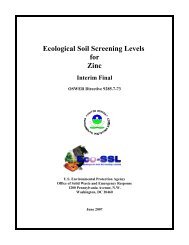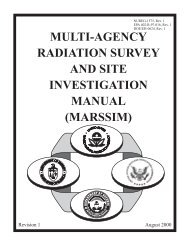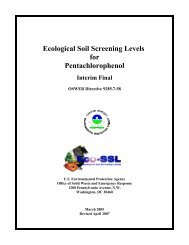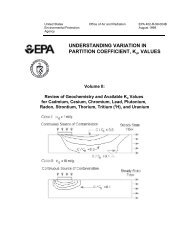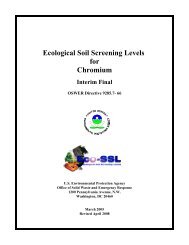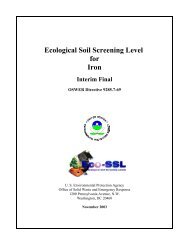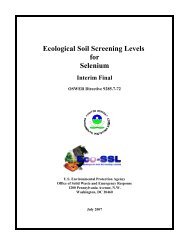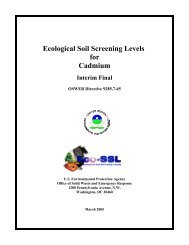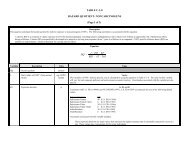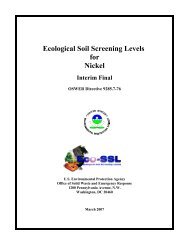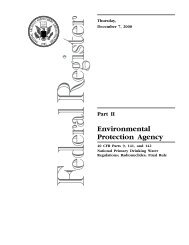Guidance for Conducting Risk Assessments and Related Risk ...
Guidance for Conducting Risk Assessments and Related Risk ...
Guidance for Conducting Risk Assessments and Related Risk ...
Create successful ePaper yourself
Turn your PDF publications into a flip-book with our unique Google optimized e-Paper software.
• ensure that data collection activities support the project data quality objectives.<br />
The site-specific data set is evaluated to ensure that the quality of the data is appropriate based on the<br />
project-specific data quality objectives. If the data evaluation has not been completed in earlier phases of<br />
the investigation, it may be completed as part of the risk assessment. Appendix B contains detailed<br />
guidance <strong>for</strong> conducting the data evaluation <strong>and</strong> determining the chemicals of potential concern (COPCs)<br />
<strong>for</strong> quantitative risk assessments. In general, the data evaluation per<strong>for</strong>med <strong>for</strong> risk assessment purposes<br />
consists of the following steps.<br />
• Evaluate analytical methods, quantitation limits, qualifiers <strong>and</strong> codes, <strong>and</strong> blanks. The risk<br />
assessor per<strong>for</strong>ms the following actions, regardless of whether the data have or have not been<br />
validated by an independent party or if the action items have already been per<strong>for</strong>med.<br />
— Evaluate the data set to ensure that the analytical methods were appropriate <strong>for</strong> the chemical<br />
analyzed <strong>and</strong> the sample matrix.<br />
— Evaluate the quantitation limits to ensure that the detection limits were not unusually high.<br />
— Evaluate the qualifiers <strong>and</strong> codes to ensure that the data are valid.<br />
— Evaluate <strong>and</strong> per<strong>for</strong>m a comparison of blank concentrations to actual sample concentrations to<br />
ensure that the concentrations were not biased by either the laboratory preparation methods or the<br />
analytical methods.<br />
• Determine if tentatively identified compounds are significant. Tentatively identified compounds<br />
are retained as chemicals of potential concern only if they are detected frequently <strong>and</strong> have been<br />
associated with site operations.<br />
• Compare data set to background <strong>and</strong> reference samples. A comparison of sample concentrations<br />
with available background concentrations is useful <strong>for</strong> identifying non-site-related chemicals <strong>and</strong><br />
radionuclides. The background values represent naturally-occurring levels of chemicals that are<br />
present under ambient conditions (i.e., not influenced by anthropogenic sources). In general, this<br />
comparison is applicable only to inorganic chemicals <strong>and</strong> a select number of radionuclides.<br />
In<strong>for</strong>mation specific to the ORR background concentrations is listed below.<br />
— Soil background concentrations <strong>for</strong> the ORR were obtained from a comprehensive ef<strong>for</strong>t. The<br />
soils data obtained from this ef<strong>for</strong>t are presented in the Final Report on the Background Soil<br />
Characterization Project at the Oak Ridge Reservation, Oak Ridge, Tennessee, Volumes 1–3<br />
(DOE 1993). These data are used to screen environmental data sets <strong>and</strong> eliminate contaminants<br />
determined to not exceed background concentrations.<br />
— Chemicals eliminated as a result of background or reference sample comparisons are discussed in<br />
the text of the baseline risk assessment report. Appendix C presents detailed guidelines on<br />
statistical approaches that can be used to compare site-specific data <strong>and</strong> background.<br />
— Groundwater background concentrations do not exist <strong>for</strong> all of the ORR; however, background<br />
concentrations <strong>for</strong> inorganic chemicals in groundwater at the Y-12 Plant were developed using<br />
groundwater data collected under the Y-12 Groundwater Monitoring Program. The methodology<br />
used to develop these background concentrations <strong>and</strong> the values themselves are contained in<br />
Determination of Reference Concentrations <strong>for</strong> the inorganic Analytes in Groundwater at the U.<br />
22



